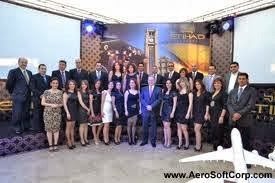Aviation is a dynamic industry comprised of millions of aviation
professionals, thousands of pieces of equipment, and an intricate web of highways in the sky and taxiways on the ground used to safely transport passengers and cargo from Point A to B. In the name of convenience and time saved, there will always be a need and desire for air transportation.
The aviation industry often experiences periods of sheer mania or
depressive panic as subject to complex governmental regulation and heavily tied to global economics. Emerging from one of the most financially challenging periods of its history, many aviation
organizations expect some hiring in 2013 and beyond. The Bureau of Labor Statistics reports, hiring will be greatest for pilots, ground
handling personnel, aerospace engineers, and mechanics.
With razor-thin profit margins, hiring the right person for the right
job at the right time has never been more important. Experts state, failed training, poor job performance, or pre-mature termination or departure of an employee can equal large financial losses in the long term.
Today’s hiring process differs significantly from years past.
According to the Air Line Pilots Association, in the pursuit of leaner operating budgets, aviation organizations have reduced or eliminated some popular employment screening tools including
background checks, psychological tests, technical skill evaluations, medical exams, telephone interviews, and written knowledge tests.
Without some of these tools available, evaluation of applicants
becomes an even more complex process.
STEPS INVOLVED IN FINDING THE MOST QUALIFIED APPLICANT:-
* Set Standards:
Create a list of requirements and determine which are “must haves” and which are negotiable. This will include regulatory requirements and characteristics desired by the organization and your customers. Once standards have been established, you should evaluate your applicants with these standards in mind.
* Evaluate Professionalism:
Professionalism is a broad concept encompassing character, desire to learn, motivation, honesty, accountability, reliability, organizational skills, teamwork, and situational awareness to name a few. Determining an applicant’s level of professionalism in itself can be difficult but necessary as part of a comprehensive applicant assessment. Personal references, motor vehicle drivers reports, criminal history, in-person or telephone interviews to evaluate communication skills, scenario-based evaluation or skills tests to observe teamwork and organizational skills, and employment history can paint an applicant’s “big picture.” Putting all these small pieces together can yield a reasonable assumption of what performance you can expect of
an applicant.
* Size-Up Motivation:
Aviation organizations spend a great amount of time and money training employees to meet minimum standards. It may take months or even years of productive employment to recoup this investment. If an applicant is using an organization as a “filler job” until he/she can obtain something better or obtaining specific training just to seek employment elsewhere, the organizational will not benefit from the investment.
Furthermore, for some positions such as pilots and flight attendants, it is important to separate those that view the industry as a lifestyle and pursuit of passion from those that view it as just a job and source of a paycheck. It is desirable to hire applicants that seek more than just extrinsic rewards in the form of compensation or benefits.
Understanding an applicant’s motivation and why he/she wants to work for your organization will ensure that training resources are not frivolously spent.
* Try them Out:
Whenever possible, observing the applicant in the real-world environment is advisable. Though barriers such as regulations, required training, security clearances, and/or potential for physical harm or inefficiency may prevent this, performing a “test run” with an applicant may be the best way to determine if he/she will be
successful. A day-on-the-job, temporary position, internship, or hiring through an approved program with regular site visits allows your organization to observe an applicant’s work methods and attitudes before a permanent position is offered.
There is no perfect aviation industry employee out there. For what one applicant will lack in technical skills or experience, he/she will make up for in motivation and professionalism. Likewise, an applicant may be technically overqualified but lack soft-skills such as effective communication or situational awareness that is vital to success in a customer service-based industry like aviation.
By utilizing the steps above, you can efficiently and effectively sift through the applicant pool by comparing the applicant’s experience to the job standards, evaluating the possibility of success through evaluation of professionalism and level of motivation, and finally whenever possible observing the applicant in the real-world aviation environment. Staying ahead of the game by forecasting hiring needs, and filling those needs before you reach a tate of despair, as well as working hard to keep those highly motivated and highly productive employees that you already have will result in smooth skies ahead.
Regards,
Vidhya Ethiraj [BE(ECE)&MBA(HR)]
Manager HR
www.AeroSoftCorp.com
www.AeroSoft.co.in
On Line Assistence :
Gtalk : VidhyaE.AeroSoft@gmail.com
Mail me on : pay2flycrew@gmail.com

























 Be an Aviator Not a Pilot
Be an Aviator Not a Pilot 














